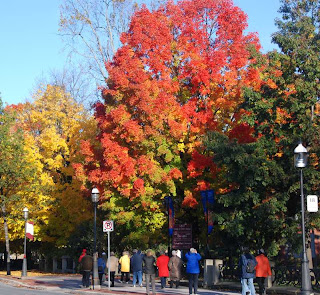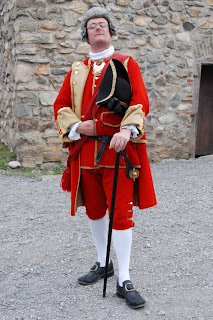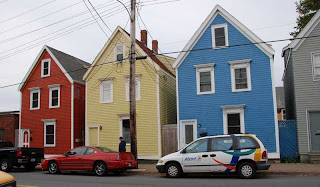It was very noticeable that there were no tourists from outside Quebec and there was almost no English spoken. We drove around Lac Saint Jean which in summer is a vacation destination, but at this time of year there is no competition for picnic tables, probably because the max temp is about 5 deg C! Although it is clear and sunny, by the time I have eaten a sandwich, my fingers are frozen.
As we drove back to Quebec there had been more snow along much of the road (about 6 inches in some places) and the trees were bare. It was the most tiring drive I have done. There was a lot of fast traffic, miles of roadworks, lots of snow and no towns to stop in.
We are staying in Levis, on the south bank of the St Lawrence opposite Quebec. Today's excursion was to take the ferry to Quebec and walk around the city. We gave the Citadel a miss, but went up and down the old streets and the newer part of the city centre which has lots of very nice boutiques and restaurants. However as far as I could work out, most buildings date from the late 1800s and later as there have been some major fires over the centuries. The most impressive thing is the site and the walls, which even when they were built were almost obsolete because of the introduction of artillery.
Tim Horton's offers a quality change from McDonalds - excellent coffee and no chips
Although the light was completely wrong, I could not resist photographing this woman salmon fishing in Saguenay. The scene looked even more idyllic before the dog with the red spotted scarf around his neck ran out of the picture.
A freighter in Saguenay Fiord. Cruise ships also come up this fiord, which is apparently a favourite haunt for whales, but not so much in October
Covered bridge Quebec province style near Ste. Jeanne d'Arc
Winter is definitely nearly here. White plastic car igloos have started appearing. Saves de-icing.
Further evidence of winter. This snow was 3 or 4 days old. On thedrive back to Quebec there was much more snow than this.
Fall is very nearly over along the Sanguenay River
Quebec moose warning signs are much more graphic than our kangaroo signs!
You don't have to be a Meccano buff to appreciate the old railway bridge at Quebec
Chute de la Chaudiere in the centre of Levis, the town opposite to Quebec. In spite of all that water, Levis citizens can only water their gardens three evenings a week
Quebec from the ferry. The castle structure is a hotel, Chateau Frontenac
Streetscape in the Vieux Port area of Quebec,
Streetscape in Quebec
Fresco in tromp l'oeil style Vieux Port area, Quebec
Halloween in Quebec
Still some Fall colours in Quebec city
























































